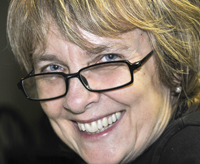
Margot Fassler, Keough-Hesburgh Professor of Music History and Liturgy and co-director of the Master of Sacred Music program at the University of Notre Dame, has won the biennial ACE/Mercers’ International Book Award.
The award from Art and Christianity Enquiry (ACE) recognizes Fassler’s 2010 book “The Virgin of Chartres: Making History Through Liturgy and the Arts” as “an outstanding contribution to the dialogue between religious faith and the visual arts.”
A detailed history of the Cathedral of Our Lady of Chartres in France, the book draws on local histories, letters, obituaries, chants, liturgical sources and reports of miracles to explore the cult of the Virgin of Chartres and its development in the 11th and 12th centuries. The book offers a detailed study of the West façade, interpreting the art in the context of liturgical and musical understandings.
“I was shocked to be a finalist, let alone to win, and very, very grateful,” Fassler says of the award, which she hopes will encourage more scholars to invest time in interdisciplinary research.
“There are no shortcuts,” she says. “You have to learn another field, and then you have to learn how to combine knowledge from two fields in creative yet responsible ways.”
Fassler says her inspiration for “The Virgin of Chartres” stemmed from an earlier book she wrote on the music and liturgy of the Abbey of St. Victor in France. The abbey was destroyed during the French Revolution, and Fassler says she was heartbroken that she could not personally experience the beauty of a place she had come to know and love through her research.
For subsequent work, Fassler looked for inspiration among buildings she could visit in person. She says she was immediately taken with Our Lady of Chartres, which has a magnificent 12th-century façade that incorporates sculpture and glass.
“I was very powerfully drawn into the ways that the music I knew would sound in my head when I looked at the art,” Fassler says of the cathedral. “Of course, it is designed to stimulate the memory, to make the glass and sculpture sound. The brilliant ways the exegetical understandings are embodied in the portal, with various uses of perspective, still continue to amaze me after all these years.
“I think the most surprising thing of all was realizing, about three years into the book, that the arts and related music constituted a giant history-making enterprise and that the identity of a community depended on knowing it, on learning to negotiate its meanings.”
A musicologist and liturgical scholar in the College of Arts and Letters, Fassler is on the faculty in both the Department of Music and the Department of Theology.
“Over the last 15 years, I have become increasingly interested in the intersection of music and art in a liturgical context,” she says. “Although I always focus on music, I am a committed interdisciplinarian. I work on music, religion and art—and I make documentary films for teaching about these subjects.”
Currently, Fassler is completing work on a textbook and a companion guide on medieval music, as well as a book on Hildegard of Bingen, which will include digital modeling, and bringing her compositions and the illuminations for one of her treatises together in an interdisciplinary study. “She demonstrates the importance of music as a theological discipline.”
Fassler is also organizing two conferences, one at the Notre Dame Centre in London, which will focus on the cantor-historian in the Middle Ages, and another featuring the compositions of James MacMillan, who will be in residence on Notre Dame’s main campus for the Feast of the Holy Cross and the Seven Sorrows in September.
Over spring break, she is escorting a class of Notre Dame undergraduate students to Chartres to learn more about the cathedral, the people and processes of reading the arts theologically.
Originally published by at al.nd.edu on December 22, 2011.